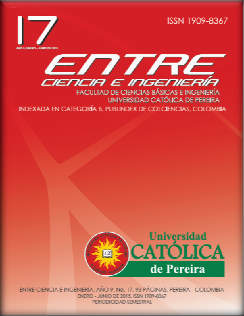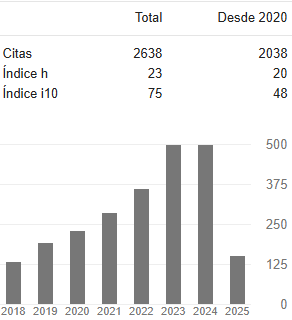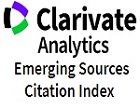Mininet: una herramienta versátil para emulación y prototipado de Redes Definidas por Software
DOI:
https://doi.org/10.31908/19098367.609Palabras clave:
Mininet, OpenFlow, Redes Definidas por Software (SDN)Resumen
Las Redes Definidas por Software (SDN) son un nuevo paradigma en redes de datos que está siendo foco de estudio e investigación en los últimos años, debido a las diferentes ventajas que tiene con respecto al funcionamiento de las redes convencionales. Las Redes Definidas por Software separan el plano de control de un dispositivo de red, del plano de datos, permitiendo controlar, monitorizar y gestionar una red desde un nodo centralizado o controlador, lo cual promete simplificar la gestión de red e incluir innovación a través de su programación.
Teniendo en cuenta que las SDNs son un tema de investigación vigente y conscientes de la importancia que tienen las herramientas que permiten simular o emular diferentes dispositivos de red para probar las nuevas soluciones propuestas por los investigadores, este artículo presenta en primera instancia una conceptualización general de Redes Definidas por Software, luego describe las diferentes herramientas de simulación y emulación más utilizadas y finalmente se enfoca en el estudio de una herramienta de emulación denominada Mininet, mostrando modos de instalación, creación de topologías de red, controladores y principales funcionalidades, revelando su versatilidad en el prototipado con este novedoso paradigma.
Descargas
Referencias
B. A. Nunes, M. Mendonca, X.-N. Nguyen, K. Obraczka and T. Turletti, “A Survey of Software-Defined Networking: Past, Present, and Future of Programmable Networks.,” Communications Surveys and Tutorials, IEEE Communications., vol. 2, no. 4, pp. 1617-1634, 2014.
ns-3. [Online]. Available: https://www.nsnam.org/. [Accessed 30 mayo 2015].
EstiNet, “EstiNet Technolgies,” 2015. [Online]. Available: http:// www.estinet.com/. [Accessed 30 mayo 2015].
Mininet, “Download/Get Started With Mininet,” [Online]. Available: http://mininet.org/download/. [Accessed 30 mayo 2015].
B. Lantz, B. Heller and N. McKeown, “A Network in a Laptop: Rapid Prototyping for Software-Defined Networks,” 2010. [Online]. Available: http://klamath.stanford.edu/~nickm/papers/a19-lantz.pdf. [Accessed 1 junio 2015].
K. Kaur, J. Singh and N. Ghumnan, “MiniNet as Software Defined Networking Testing Platform,” 2014. [Online]. Available: http:// www.sbsstc.ac.in/icccs2014/Papers/Paper29.pdf. [Accessed 08 mayo 2015].
C. Pal, S. Veena , . R. P. Rustagi and . K. Murthy, “Implementation of Simplified Custom Topology Framework in Mininet,” Asia-Pacific Conference on Computer Aided System Engineering (APCASE), pp. 48 - 53, 2014.
R. . L. Santos de Oliveira, C. M. Schweitzer, A. A. Shinoda and L. Rodrigues Prete, “Using Mininet for Emulation and Prototyping,” IEEE Colombian Conference on Communications and Computing (COLCOM)., pp. 1 - 6, 2014.
D. Mehmet and A. Mostafa , “Design and analysis of techniques for mapping virtual networks,” Computer Communications, 2014.
J.-R. Jiang, H.-W. Huang, J.-H. Liao and S.-Y. Chen, “Extending Dijkstra’s Shortest Path Algorithm for Software Defined Networking,” Asia-Pacific Network Operation and Management Symposium (APNOMS), 2014.
Sang Min Park, Seungbum Ju and Jaiyong Lee, “Efficient routing for traffic offloading in Software-defined Network,” International Workshop on Software Defined Networks for a New Generation of Applications and Services (SDN-NGAS-2014), 2014.
Kannan Govindarajan, Sharipah Setapa, Kong Chee Meng and Hong Ong, “Interoperability Issue between IPv4 and IPv6 in OpenFlow Enabled Network,” 2014 International Conference on Computer, Control, Informatics and Its Applications, 2014.
D. Kreutz, F. Ramos, P. E. Veríssimo, C. E. Rothenberg, S. Azodolmolky and S. Uhlig, “Software-Defined Networking: A Comprehensive Survey,” Proceedings of the IEEE, vol. 103, no. 1, pp. 14-76, 2015.
N. McKeown, G. Purulkar, S. Shenker, T. Anderson, L. Peterson, J. Turner, H. Balakrishnan and J. Rexford, “OpenFlow: Enabling Innovation in Campus Networks,” 2008. [Online]. Available: http:// archive.openflow.org/documents/openflow-wp-latest.pdf. [Accessed 26 mayo 2015].
Ó. Roncero, “Software Defined Networking,” 2014. [Online]. Available: http://upcommons.upc.edu/pfc/bitstream/2099.1/21633/4/ Memoria.pdf. [Accessed 2015 mayo 08].
D. Tennenhouse and D. Wetherall, “Towards an active network architecture,” in DARPA Active NEtworks Conference and Exposition, 2002. Proceedings, San Francisco, IEEE, 2002, pp. 2-15.
University of Cambridge, “Devolved Control of ATM Networks.,” [Online]. Available: http://www.cl.cam.ac.uk/research/srg/netos/oldprojects/dcan/#intro. [Accessed 2015 mayo 2015].
R. Enns, E. M. Bjorklund, J. Schoenwaelder and A. Bierman, “Network Configuration Protocol (NETCONF),” RFC 6241, 2011.
M. Casado, M. Freedman, J. Pettit, J. Luo, N. McKeown and S. Shenker, “Ethane: taking control of the enterprise,” ACM SIGCOMM Computer Communication Review, vol. 37, no. 4, pp. 1-12, 2007.
Open Networking Foundation, “Software-Defined Networking: The New Norm for Networks,” 2012. [Online]. Available: https://www. opennetworking.org/images/stories/downloads/sdn-resources/whitepapers/wp-sdn-newnorm.pdf. [Accessed 08 mayo 2015].
S. Sezer y et. al., «Are We Ready for SDN? Implementation Challenges for Software-Defined Networks,» IEEE Communications Magazine, vol. 51, nº 7, pp. 36-43, July 2013.
A. Bianco, V. Krishnamoorthi, N. Li and L. Giraudo, “OpenFlow driven ethernet traffic analysis,” in 2014 IEEE Internacional Conference on Communications (ICC), Sydney, IEEE, 2014, pp. 3001-3006.
S.-Y. Wang, C.-L. Chou and C.-M. Yang, “EstiNet openflow network simulator and emulator,” IEEE Communications Magazine, vol. 51, no. 9, pp. 110-117, 2013.
PlanetLab. [Online]. Available: https://www.planet-lab.org/. [Accessed 30 mayo 2015].
Emulab, “Emulab: Total Network Testbed,” 2015. [Online]. Available: https://www.emulab.net/. [Accessed 30 mayo 2015].
M. Schwarz, M. Rojas, C. Miers, F. Redigolo and T. Carvalho, “Emulated and software defined networking convergence,” in 2013 IFIP/IEEE International Symposium on Integrated Network Management (IM 2013), Ghent, IEEE, 2013, pp. 700-703.
OFELIA, 2014. [Online]. Available: http://www.fp7-ofelia.eu/. [Accessed 30 mayo 2015].
M. Suñé, B. L., W. H., T. Rothe, A. Köpsel, D. Colle, B. Puype, D. Simeonidou, R. Nejabati, M. Channegowda, M. Kind, T. Dietz and A. Autenrieth, “Design and implementation of the OFELIA FP7 facility: The European OpenFlow testbed,” Computer Networks, vol. 61, p. 132–150, 2014.
MiniNet, “MiniNet: An Instant Virtual Network on your Laptop (or other PC),” 2015. [Online]. Available: www.mininet.org. [Accessed 26 mayo 2015].
S. Wang and H. Kung, “A Simple Methodology for Constructing extensible and high-fidelity TCP/IP network simulators.,” in INFOCOM ‘99. Eighteenth Annual Joint Conference of the IEEE Computer and Communications Societies. Proceedings., vol. 3, New York, IEEE, 1999, pp. 1134 - 1143.
NOX, 2015. [Online]. Available: http://www.noxrepo.org/. [Accessed 30 mayo 2015].
N. Gude, B. Pfaff, T. Koponen, M. Casado, S. Shenker, J. Pettit and N. McKeown, “NOX: Towards an Operating System for Networks,” Computer Communication Review, vol. 38, no. 3, pp. 105-110, 2008.
RYU, “Component-based software defined networking framework. Build SDN Agilely,” 2014. [Online]. Available: http://osrg.github.io/ ryu/. [Accessed 30 mayo 2015].
Floodlight, “Floodlight OpenFlow Controller,” [Online]. Available: http://www.projectfloodlight.org/floodlight/. [Accessed 30 mayo 2015].
“Open Networking Summit 2013,” Santa Clara, CA, 2013.
S.-Y. Wang, “Comparison of SDN OpenFlow network simulator and emulators: EstiNet vs. Mininet,” in IEEE Symposium on Computers and Communications (ISCC), Funchal, 2014.
” VirtualBox,” [Online]. Available: https://www.virtualbox.org/.
“Wireshark,” [Online]. Available: https://www.wireshark.org/.
“Mininet Python API Refence Manual,” [Online]. Available: http:// mininet.org/api/hierarchy.html. [Accessed 31 mayo 2015].
A. Bagewadi and R. M. Babu, “Towards an Ethernet Learning Switch and Bandwidth Optimization using POX Controller,” International Journal of Advanced Research in Computer and Communication Engineering, vol. 3, no. 7, pp. 7531-7535, 2014.
Mininet, “Using a Remote Controller,” [Online]. Available: http:// mininet.org/walkthrough/#using-a-remote-controller. [Accessed 31 mayo 2015].
D. Erickson, “The Beacon OpenFlow Controller,” [Online]. Available: http://yuba.stanford.edu/~derickso/docs/hotsdn15-erickson.pdf. [Accessed 31 mayo 2015].
“CPqD,” [Online]. Available: http://www.cpqd.com.br/es/.
“nox13oflib,” [Online]. Available: https://github.com/CPqD/ nox13oflib. [Accessed 31 mayo 2015].
W. Braun and M. Menth, “Software-Defined Networking Using OpenFlow: Protocols, Applications and Architectural Design Choices,” Future Internet, vol. 6, no. 2, pp. 302-336, 2014.
“OpenFlow 1.3 Tutorial,” 2013. [Online]. Available: https://github. com/CPqD/ofsoftswitch13/wiki/OpenFlow-1.3-Tutorial. [Accessed 31 mayo 2015].
“Mininet-discuss mailing list,” [Online]. Available: https://mailman. stanford.edu/mailman/listinfo/mininet-discuss.
S. Deering and R. Hinden, “Internet Protocol, Version 6 (IPv6),” RFC2460, p. 39, 1998.
E. Rosen, A. Viswanathan and R. Callon, “Multiprotocol Label Switching Architecture,” RFC3031, 2001.
D. Katz, K. Kompella and D. Yeung, “Traffic Engineering (TE) Extensions to OSPF Version 2,” RFC3630, p. 14, 2003.
D. Awduche, L. Berger, D. Gan, T. Li and V. Srinivasan, “RSVP-TE: Extensions to RSVP for LSP Tunnels,” RFC3209, 2001.
C. Perkins, D. Jhonson and J. Arkko, “Mobility Support in IPv6,” RFC6275, 2011.
Descargas
Publicado
Número
Sección
Licencia
Derechos de autor 2019 Entre Ciencia e Ingeniería

Esta obra está bajo una licencia internacional Creative Commons Atribución-NoComercial 4.0.



















